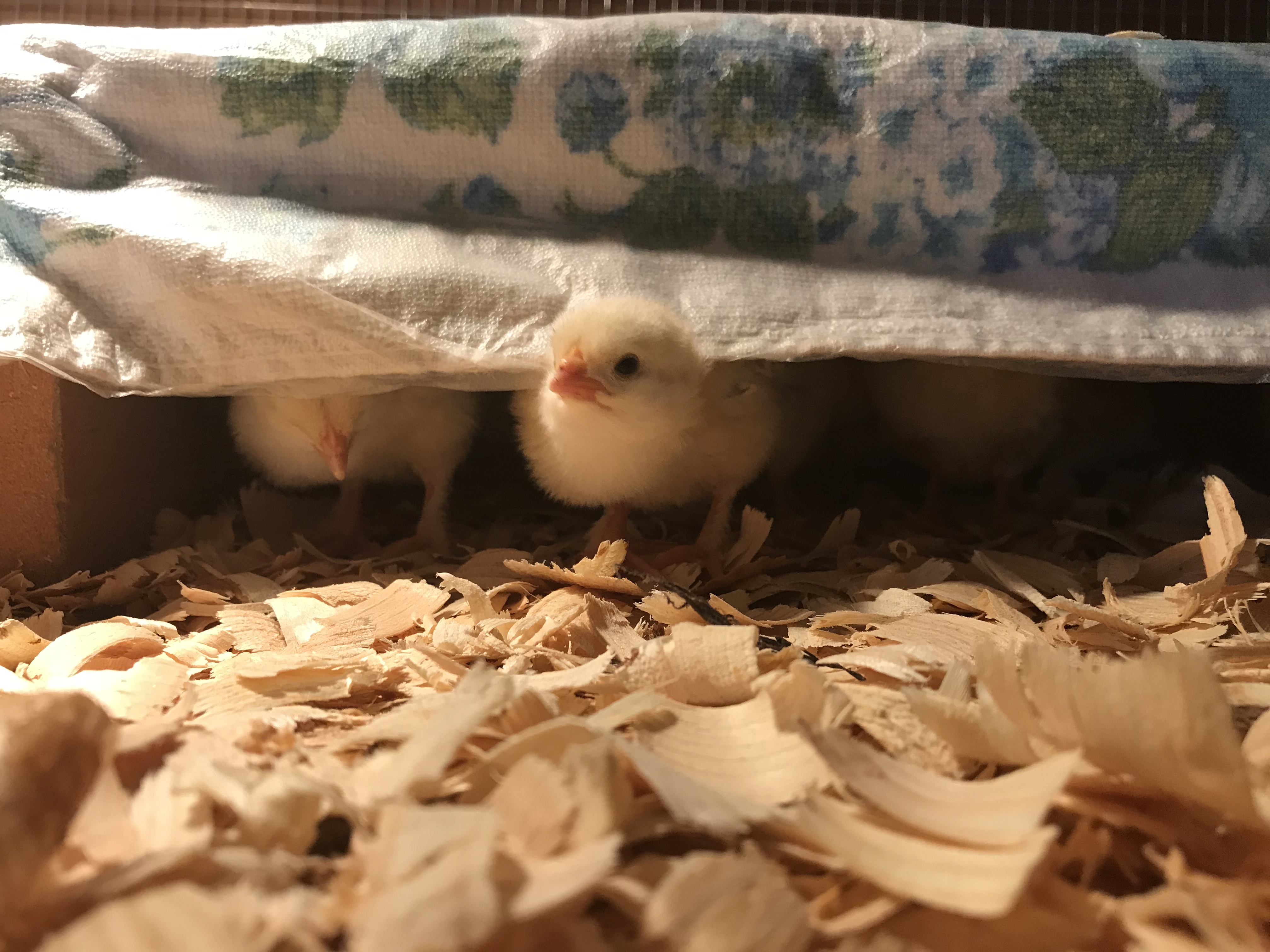
This post will tell about a hard left turn that I took this week in my chicken keeping practices. Let me start by quoting three wise sayings:
- Anonymous Proverb: “You learn something new every day.”
- King Solomon famously wrote, “There’s nothing new under the sun.”
- The Apostle Paul wrote, “I will show you a more excellent way.”
This post will offer echos of all of these.
You Learn Something New… If You’re Willing to Learn
I love learning new things about keeping chickens, even though I’m four years young in the hobby. To this end, I’m an avid researcher. One of the best resources for me (especially since I lack a mentor in real life and live on an isolated mountain farm in WV) is the community called Backyard Chickens. There is a wealth of experience and a wonderful supportive, welcoming atmosphere on the forums at backyardchickens.com. When I first started keeping chickens, it was my daily (often hourly) go-to spot; nowadays, I often go there for recreation or just to surf and learn.
So, after I discovered and built my first Hover Brooder, I was excited to share about it with that community and added a post to an existing thread about brooders. In response, a wonderful, experienced, and kind chicken keeper, named Diane, commented on my post. She supported the Hover Brooder I had built, but also related that it was possible to raise chickens outdoors without heat lamps and in a way far more natural to the rhythms of life and growth of young chicks that God originally ordained.
I am so glad that I had the humility to explore her method, even though I was at the time so excited about my own.
There’s Nothing New… Or Is There?

It’s new to me, but the method that Diane introduced mimics the way that God created the brooding process for chicks. (Diane will be the first to share that it’s not her method; her post about this method was the one that caught a lot of eyes, has remained active over years, and still has her present on it to answer questions—again and again!) This widely known, modern adaptation to natural brooding is generally known as the Mama Heating Pad (MHP) method.
In the wild, mama chickens set on their eggs (brood them) for 21 days. When new chicks emerge from their eggs, weak and wet, they rest and then dry, and then gain strength, all under the hen’s body and soft downy feathers that warm them from above. Very soon, they peek out from under their mama, and then as she rises to eat, drink, and scavage and scratch for food, they follow and mimic her. If they get chilled, they run back under mama’s fluff to warm up, then reemerge. After about four weeks, they are fully feathered, and too large to fit under mama. They then huddle next to each other and mama as they leave her side more and more.

In a nutshell, with the MHP method a heating pad is placed low to the floor of a brooder pen, over shavings or straw: your choice. The pad is supported by a simple wire frame made of garden fencing (or some use more elaborate supports, like old cookie cooling racks), and covered by an old towel, which is then covered in Press N Seal, for help with keeping it clean.
The theory of this arrangement is that the chicks run under the heating pad and warm their backs via direct contact with it. (The heating pad must NOT have an auto-off feature, or MUST have the ability to DISABLE that auto-off feature).
Once under “mama,” new chicks may sleep under “her” as well. After being sufficiently warmed by “mama,” they often emerge to eat, drink, and/or explore their surroundings. As soon as they are chilled, they scurry back under “mama” for another warm up. When ambient temperatures are warm enough, they will also doze on “mama’s” back!

As night approaches, and light dwindles, the chicks naturally fill up their crops and bed down under “mama.” Chickens, like most birds, do not eat, drink, or move around at night. They eat and drink heavily before dark, and then roost for the night. Broody hens will collect their chicks under themselves, settle down, and sleep. So will their chicks—warm under her feathers. The MHP simulates all of this: and you have blessed quiet and dark all night long in the brooder.
And, because the MHP does not work by heating ambient airs… either under the MHP or outside of it… but by direct contact with chicks’ backs, this brooder can be used effectively in sub-freezing barn environments, even as mama chickens can brood their young in such environments.
So, while this is a new-to-me method, and is using modern electricity, it is also an old, old approach to brooding baby chicks: about as close as you can get to simulating a true mama chicken without having a broody hen.
A More Excellent Way!
How is this more excellent? Glad you asked!
Let me count the ways!
- There is no danger of fire from heat lamps, which has always been a concern to those who use them.
- There are no accidental burns from heat lamps, which is great especially when grandchildren are helping with (and/or enjoying) newly hatched chicks.
- The MHP method supports the establishment of night/day cycle in chicks which is the most natural to them.
- Chicks choose their degree of warmth and/or activity freely.
- You can brood in unheated spaces: garages, barns, etc. (They still need protection from predators and drafts.)
- It uses less electricity to heat a pad than two heat lamps (for redundancy). This fact also reduces the danger of overloading the circuit, causing a breaker to trip in the night and losing all heat (which has happened to us).
- Chicks learn natural day/night cycles; they are not unduly stressed by constant bright light. This has to be as good for them as it is for us: deep night sleeps and active days with eating/drinking has to equal happier, healthier, better adjusted chicks, at least to my way of thinking.
- We go through less feed/water as a result of their sleeping soundly all night.
- Chicks may feather faster. (I have yet to experience this one for myself.)
Let Me Show You This More Excellent Way!

In case you’d like to follow in my footsteps, first let me link you to the original (loooong) thread that I consulted on Backyard Chicken forums.
You’ll find pictures and information galore there, but if you want a summary, here it is:
- The original idea is that you take garden wire (2×4” welded wire is probably best, since it’s more rigid than poultry netting, and yet open enough to allow chicks to get maximum contact with the heating pad) and bend it into a shallow arc, forming a cave of sorts. (Some newer adaptations use a cookie cooling sheet for support, and may use more rigid sides. I did this latter modification with my second MHP; see below.) Again, you want to make sure that the structure slopes upwards from back to front such that the ceiling in the back will be about 2.5” above the shavings (for day-old peeps).
-

Wire frame properly bent Over this wire frame, we then put a naked heating pad. Most such have writing on one side, indicating the side you’re to put next to the human body. Put this side down, towards the chicks. Make sure to buy one that does NOT have an auto-off feature, or has the ability to turn off this feature. You don’t want the pad kicking off automatically—ever! (They can be hard to find. Here’s a large model that’s sold on Amazon and at WalMart (and in the picture above, showing what you’ll need). Currently, they sell for around $20 w/free shipping on Amazon. It has NO auto-off feature. I set mine on medium, no matter the ambient air, for day-old to week-old chicks.)
-

Draped towel and Press N Seal half added Over the pad, drape a hand towel, large enough to lap over the front and back.
- Affix some Press ‘N Seal wrap to the top of the towel (wrapping the sides) as a poop deflector. (After each use of the MHP, you can either wipe this surface, or remove it and redo it to clean up.)
- Put the MHP assembly over shavings or straw. It should be that it slopes front to back: make it 2.5” above the flooring in the back, and about 4” above on the front, with the towel falling over the front about 2” as an “awning.”
- Cover the sides and back, if desired, with shavings/straw. (Some leave the back open for egress; some close it with a towel and then back that with deep shavings. This latter was my approach. It depends somewhat on ambient air temps and also on how large the hatch is. What you want to avoid is chicks getting trapped inside. My pads are 12” x 24”, and my hatch was 10 chicks: plenty of room for everyone to come and go freely.)
-

MHP in trough brooder indoors Cover the top of the MHP with shavings/straw. The chicks will hang out there when the ambient temps are warm, and snuggle/snooze in the warmth of the top of the MHP.
- Over time, as chicks grow (and they grow fast) you’ll want to raise the MHP and lower the heat setting on your heating pad. You can raise it by simply putting lumber, stones, bricks, or whatever under the sides of the MHP.
Details About My MHP for Outdoor Brooding:

I ended up with kind of a hybrid between the original design (just bent wire) and those with rigid frames. We cut a 2” x 8” board diagonally such that each piece was 2.5” at the back and 4” at the front, and 12” long. We put a 23” 2×4 at the back, and screwed the side pieces to it. Then, we attached garden wire to the top, with the pad on top of that.
The 2×4 back was higher than the low ends of the sides, making a lip of sorts, such that the pad cannot slip backwards.
The wire was stapled to the flat tops of the two sides.
Then, I put a towel over the pad, and affixed the Press N Seal to it, and filled in with shavings below, as well as an insulative board, since this pen is off the floor in an unheated barn. The towel was arranged with a generous “awning” in the front, again, to keep heat in and cold air out, and we added plenty of wood shavings under and on top.
Transferring My 5-Day Old Chicks to Outdoor Conditions

We already had heat lamps installed above the pen, So I warmed up the ambient air with one heat lamp over their food/water, and left it on until 8:30 PM that night. (It’s on a timer: it will be their “sun,”going on each day at 6:30 AM, about an hour before sunrise here.
When I transferred them, I was taking them from ambient 70° airs in the house to ambient 48° in the barn at noon on a sunny March day. The solo heat lamp was my way of making MYSELF feel better… 

I brought the chicks out, starting at noon, and made excuses for sticking around the barn working with adult pens all afternoon, preparing for an expected snowfall and making improvements on my Family Coops. The chicks did great. They went in and out of their MHP cave, ate and drank, and took naps just as they had in the house.
In the morning, at 9 AM, the heat lamp had gone back on and the water was liquid. Two chicks were out eating and drinking, and eight more were cozy under their MHP, hanging out.
Conclusions

For me, there is no way I’m going back to heat lamps, in any form, including the hover brooder I was so proud of last week. 
UPDATE: 5 days later…
Chicks are all happy, healthy, and growing! They have been living in our unheated barn while we received 16” of snow, and have had most nights in the low 20°s. Last night was 16°! Chicks were all doing fine this morning.








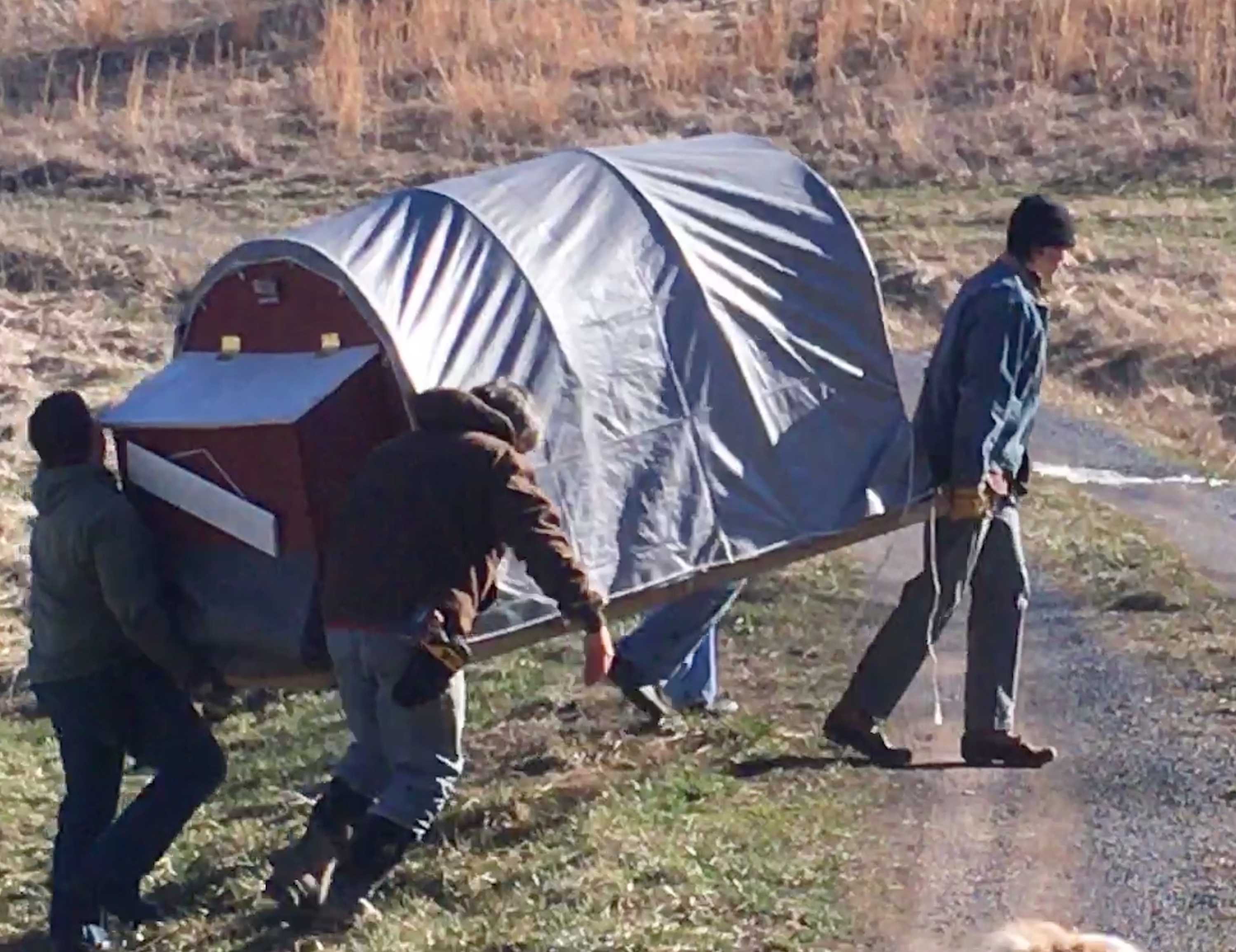

 So, on Saturday morning at 9 AM, the men showed up and they moved seven 500 lb. breeding coops UPhill on Saturday morning. We decided to move the birds in their coops. The birds had already been shut in all of Friday because we had 70 mph winds here and had to keep them safe.
So, on Saturday morning at 9 AM, the men showed up and they moved seven 500 lb. breeding coops UPhill on Saturday morning. We decided to move the birds in their coops. The birds had already been shut in all of Friday because we had 70 mph winds here and had to keep them safe.
 In the process of building the runs and moving the coops, we relocated some of the birds’ relative positions. As they were let out into new runs, our best Light Sussex cock and our best Silver Penciled Rock cock found themselves separated by only a wire fence, and they did not like it, not one little bit! As I worked on more runs on Monday evening, I watched these two cocks get into a massive fight through the wire that left them both bleeeding.
In the process of building the runs and moving the coops, we relocated some of the birds’ relative positions. As they were let out into new runs, our best Light Sussex cock and our best Silver Penciled Rock cock found themselves separated by only a wire fence, and they did not like it, not one little bit! As I worked on more runs on Monday evening, I watched these two cocks get into a massive fight through the wire that left them both bleeeding.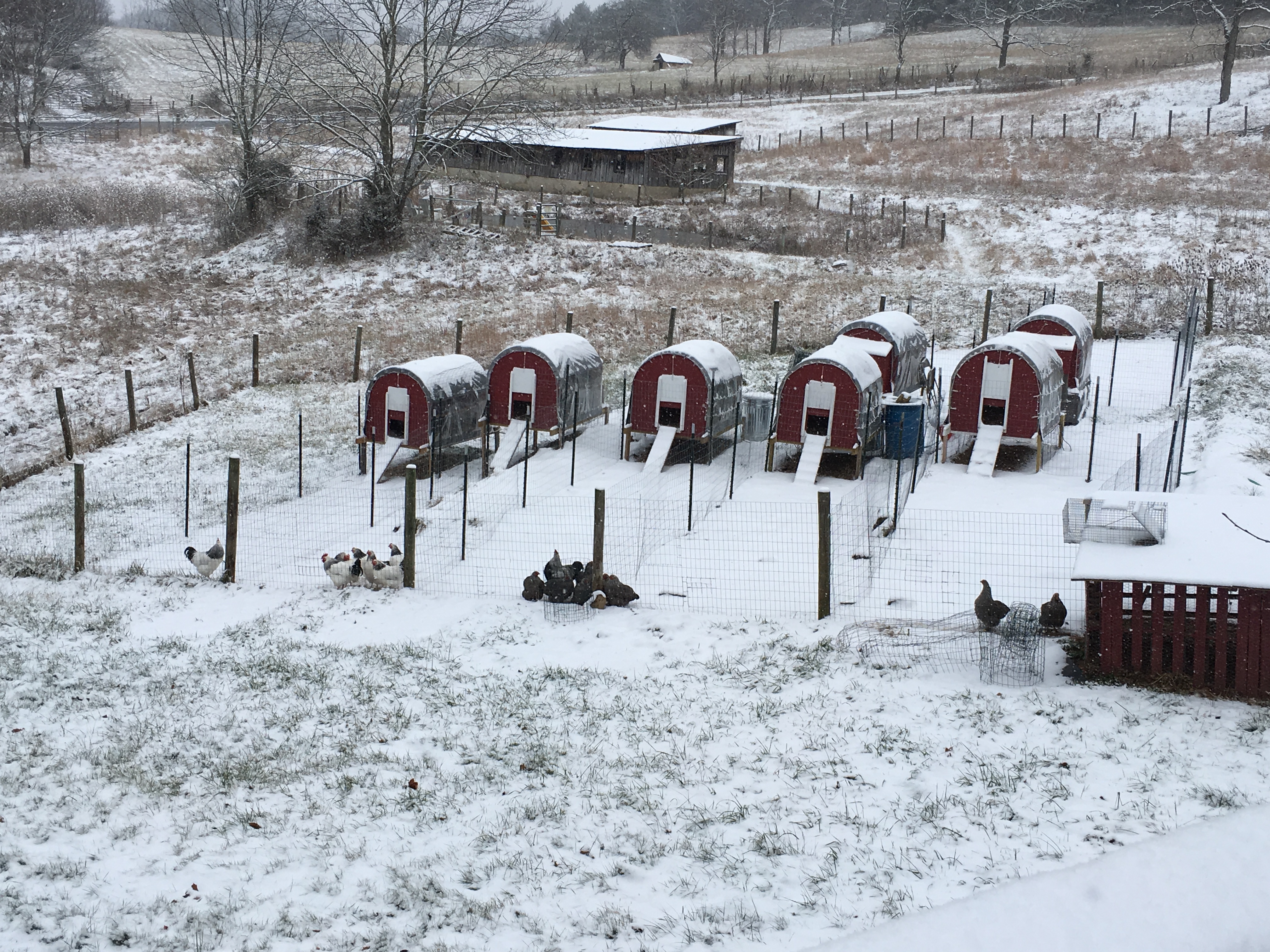



 Most of the day, this scene has remained fairly static.
Most of the day, this scene has remained fairly static.


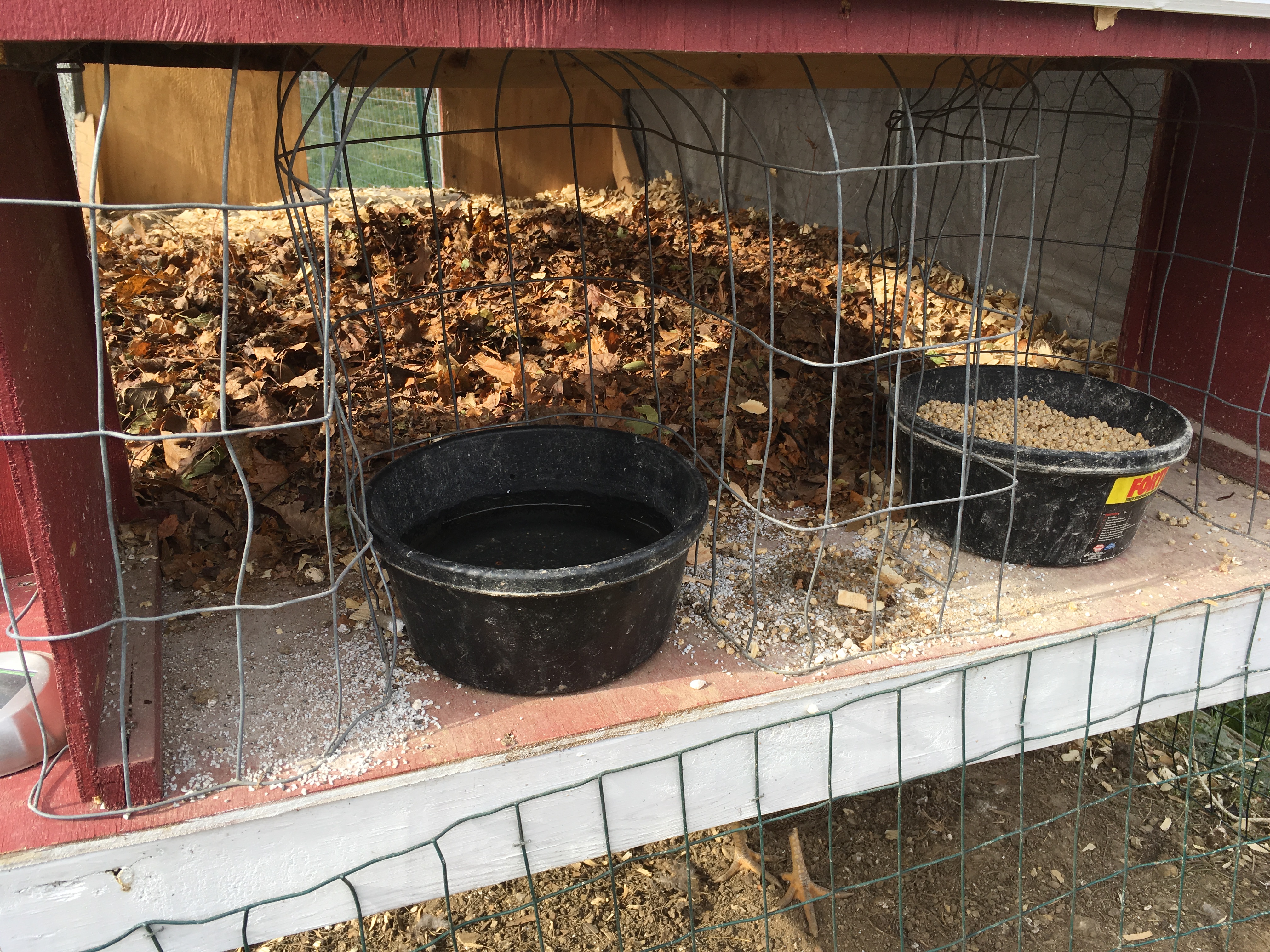




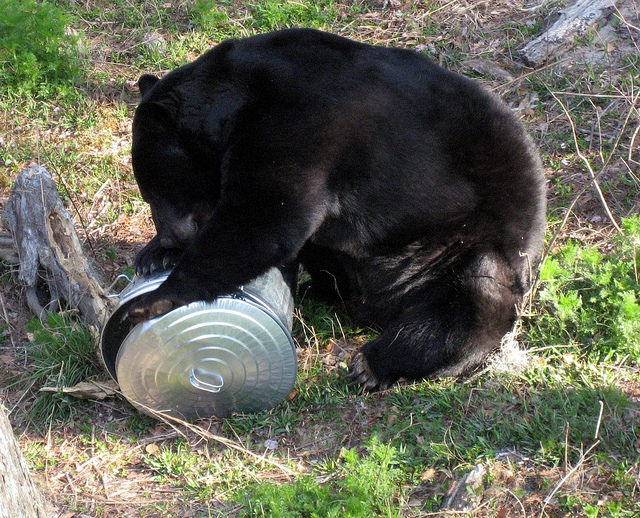
























 More recently, we have made a great discovery for non-sewers, though! We have used a corrugated plastic panel and put the tarp over top. It works great! On the left is a pictur of one in production.
More recently, we have made a great discovery for non-sewers, though! We have used a corrugated plastic panel and put the tarp over top. It works great! On the left is a pictur of one in production.
 To continue: the coop’s pop door that is operated from the coop’s back side by a clothesline. The farmer, standing in front of the nest box and feeding station at the coop’s back, can 1) collect eggs, 2) open/close the pop door, and 3) feed and water the coop’s occupants.
To continue: the coop’s pop door that is operated from the coop’s back side by a clothesline. The farmer, standing in front of the nest box and feeding station at the coop’s back, can 1) collect eggs, 2) open/close the pop door, and 3) feed and water the coop’s occupants.




 We live in the mountains of WV, where temperatures do go to zero in some months of the winter. In the fall, staple feed bags or landscaping cloth over the wire floor of the coop and fill it with dried fall leaves and wood shavings to a depth of 4″. Deep litter will result, insulating and remaining in the coop until spring (with monthly additions), when we will remove the barrier and the coop will become self cleaning again.
We live in the mountains of WV, where temperatures do go to zero in some months of the winter. In the fall, staple feed bags or landscaping cloth over the wire floor of the coop and fill it with dried fall leaves and wood shavings to a depth of 4″. Deep litter will result, insulating and remaining in the coop until spring (with monthly additions), when we will remove the barrier and the coop will become self cleaning again.